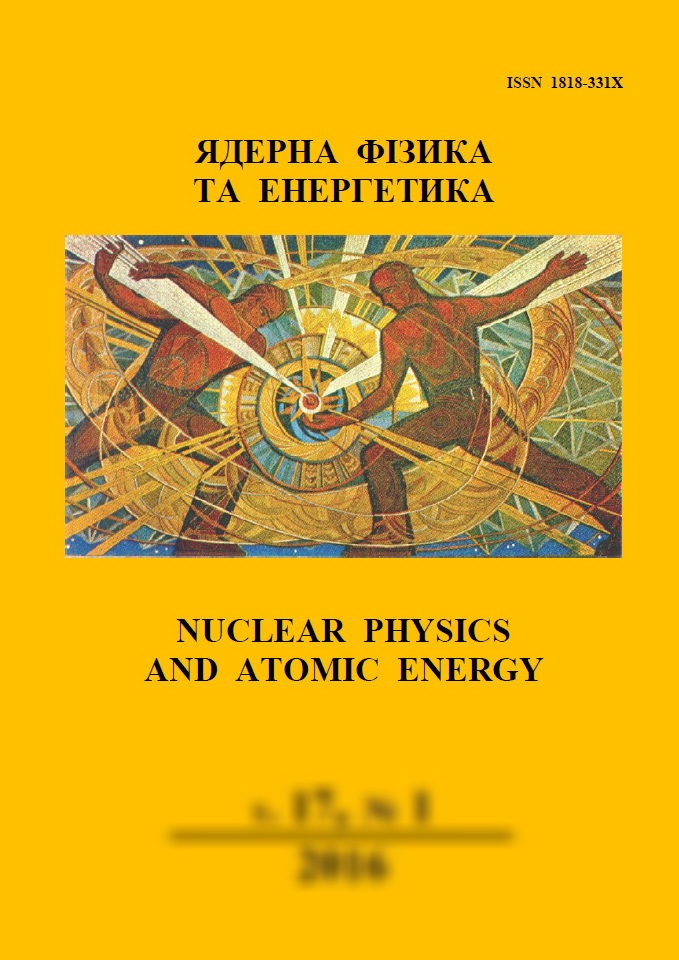 |
Ядерна фізика та енергетика
Nuclear Physics and Atomic Energy
ISSN:
1818-331X (Print), 2074-0565 (Online)
Publisher:
Institute for Nuclear Research of the National Academy of Sciences of Ukraine
Languages:
Ukrainian, English
Periodicity:
4 times per year
Open access peer reviewed journal
|
Nucl. Phys. At. Energy 2001, volume 2, issue 3, pages 171-176.
Section: Radioecology and Radiobiology.
Received: 26.02.2001; Published online: 30.09.2001.
 Full text (ru)
Full text (ru)
https://doi.org/10.15407/jnpae2001.03.171
The acumulation of radionuclides and heavy metals by mushroom's complex in forestry ecosystems
O. B. Tsvetnova1, N. E. Shatrova2, A. I. Shcheglov1
1M. V. Lomonosov Moscow State University, Moscow, Russia
2Institute for Nuclear Research of the National Academy of Sciences of Ukraine, Kyiv, Ukraine
Abstract:
Comprehensive studies of the mycobiota contribution to the biogeochemical migration of heavy
metals (HM), radionuclides and their stable isotopic and non-isotopic carriers under native conditions have
been carried out in contaminated forests of Russia and Ukraine (1988 - 2000). It was shown that species is a
prime factor of 137Cs accumulation by the fungi. The so-called "concentrator" group is now clearly
represented by Xerocomus badius, Suillus luteus and Tylopilus felleus. 137Cs content in the fungus mycelium
is close to that in the fruit bodies. No significant difference in 137Cs concentration was revealed depending on
the fruit body part or age. Spatial variability of 137Cs content in the fungi was considerably higher compared
to other radionuclides and HM. The contribution of fungus complex to the biogeochemical migration of the
various contaminants depends on both the chemical nature of the contaminant and soil-ecological conditions.
The contribution is most manifested for 137Cs, especially in hydromorphic landscapes (up to 50% of total
accumulation in the biota).
References:
1. Цветнова О. Б., Щеглов А. И. Аккумуляция 137Cs высшими грибами и их роль в биологической миграции нуклида в лесных экосистемах. Вестник МГУ. Сер. почвоведение 4 (1996) 59.
2. Щеглов А. И., Тихомиров Ф. А., Цветнова О. Б. и др. Биогеохимия радионуклидов чернобыльского выброса в лесных экосистемах Европейской части СНГ. Радиационная биология. Радиоэкология 36 (1996) 469.
3. Щеглов А. И. Биогеохимия техногенных радионуклидов в лесных экосистемах (Москва: Наука, 1999) с. 268.
4. Tsvetnova O. B., Shcheglov A. I. 137Cs content in the mushrooms of radioactive contaminated zones of European part of CIS. The Science of Total Environment 155 (1995) 25.
https://doi.org/10.1016/0048-9697(94)90358-1
5. Коваль Г. М., Шатрова Н. Є. Вміст радіонуклідів аварійного походження у грибах (макроміцетах) Чорнобильської зони відчуження. Чорнобиль. Зона відчуження (Київ.: Наук. думка, 2001) c. 378.
6. Лес. Человек. Чернобыль. Лесные экосистемы после аварии на Чернобыльской АЭС: состояние, прогноз, реакция населения, пути реабилитации. Под ред В. А. Ипатьева (Гомель: Ин-т леса НАН Беларуси, 1999) c. 137.
7. Wirth E., Kammerer L. Cycling of cesium and strontium in coniferous forest in South - Bavaria. The behaviour of Radionuclides in Natural and Semi-Natural Environments (Rome, Italy, 10 - 11 Feb., 1992) p. 15.
8. Кучма М. Д., Архіпов М. П., Бідна С. М. Радіоекологічна та лісівнича ситуація в лісах зони відчуження. Наук.-практ. конф. "Наука. Чорнобиль-96": Збірка тез (Київ, 1997) c. 53.
9. Федоров В. Н. Sr-90 в плодовых телах высших макромицетов. Тез. докл. 2-го радиобиолог. съезда, Киев, 20 - 25 сент. 1993 г. (Пущино, 1993) Т. 2, c. 1034.
10. Перельман А. И. Геохимия ландшафта (Москва: Высш. шк., 1975) c. 342.
